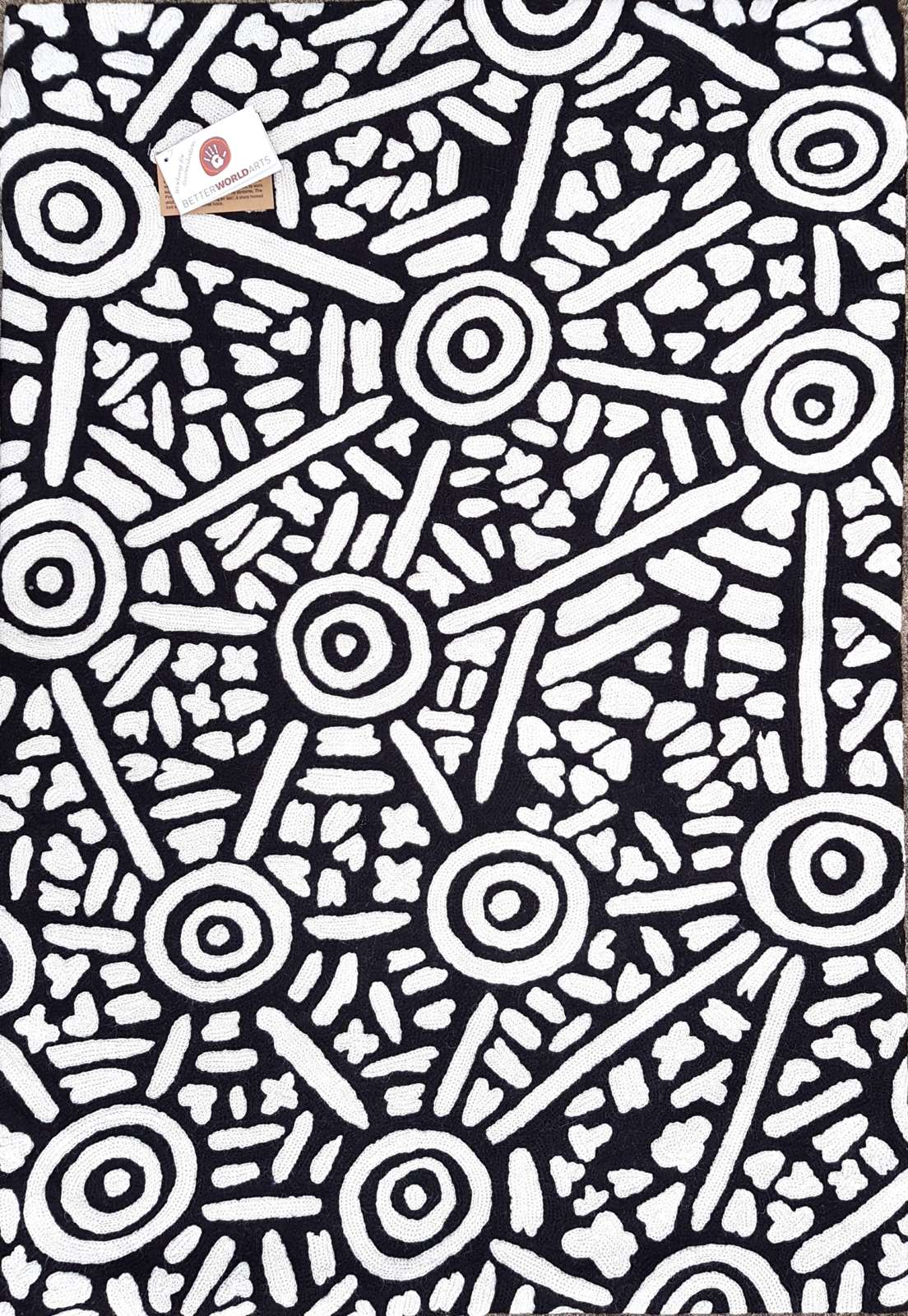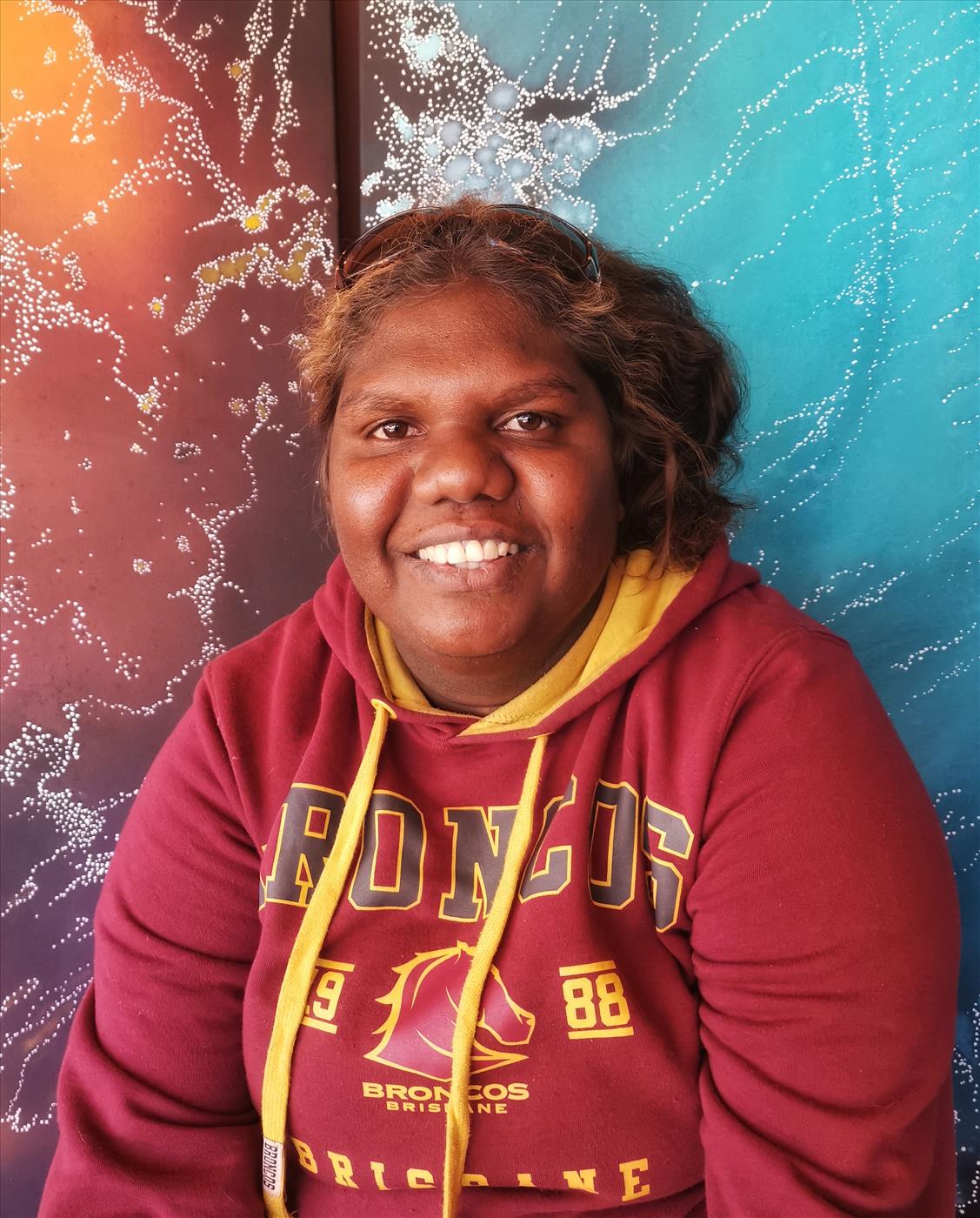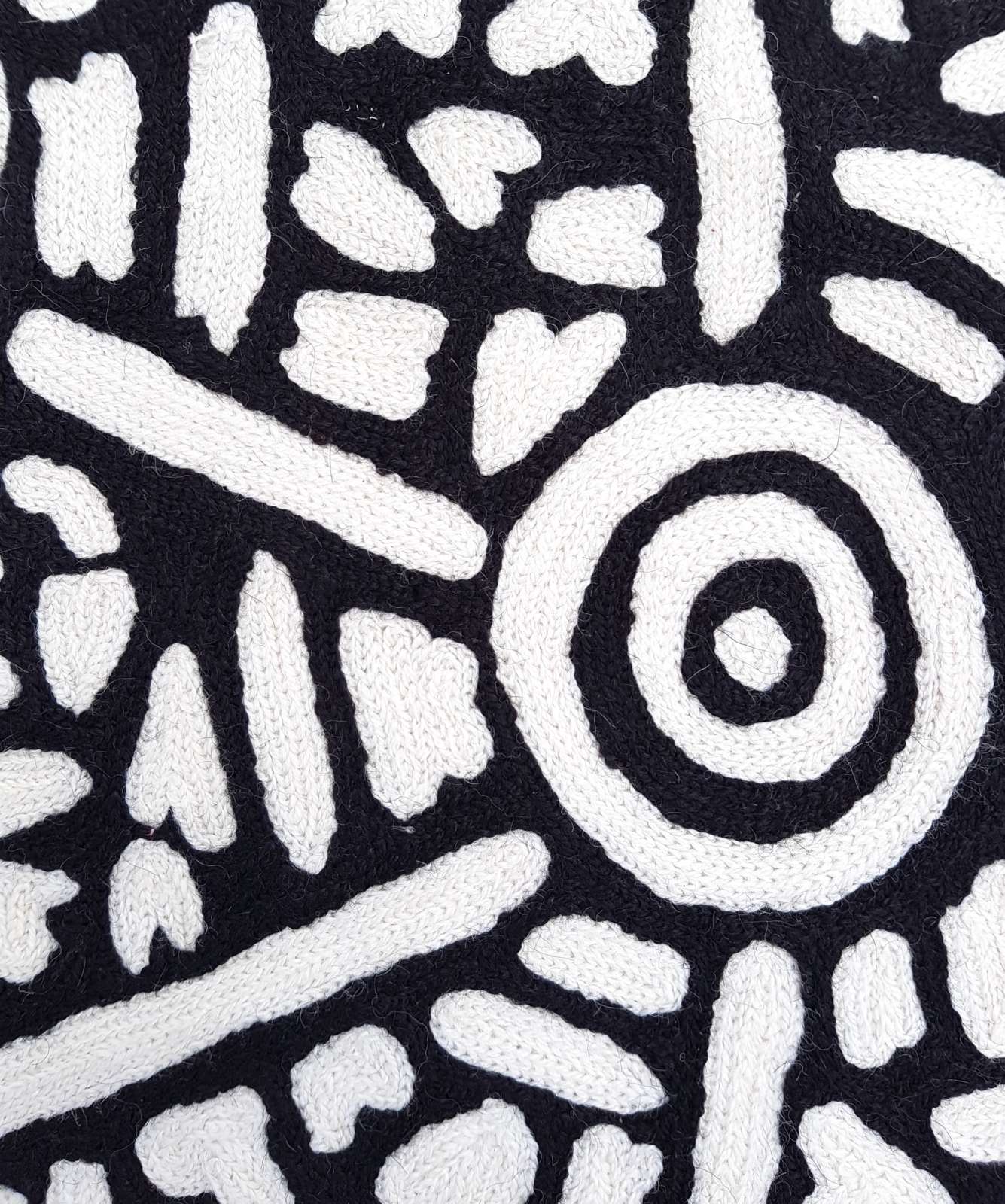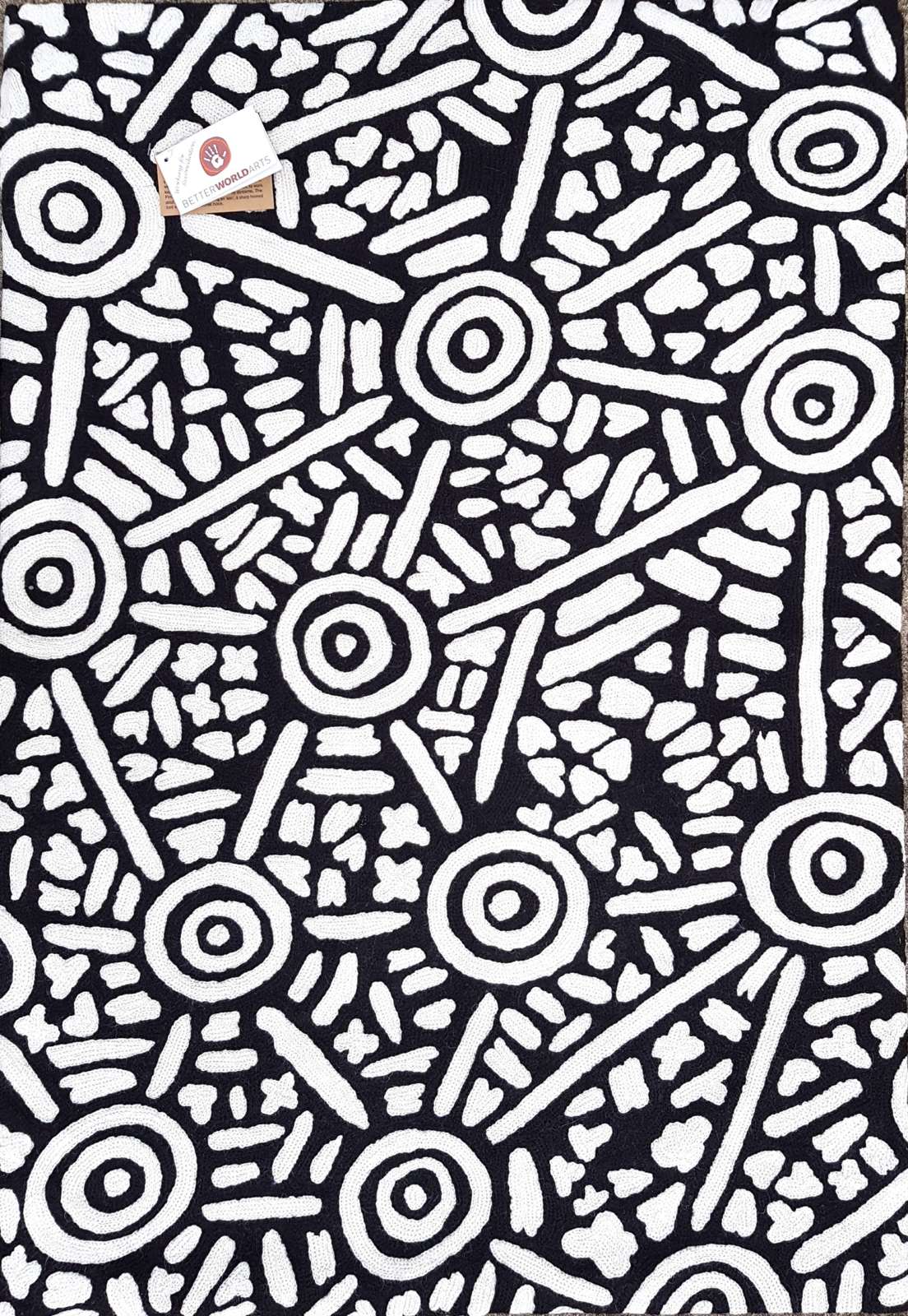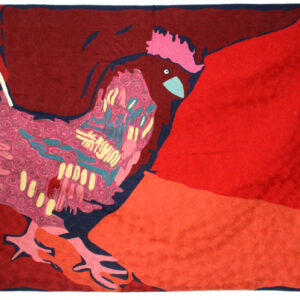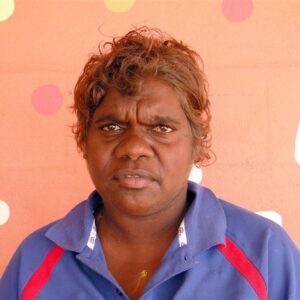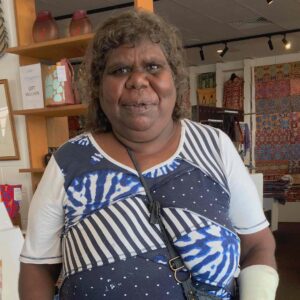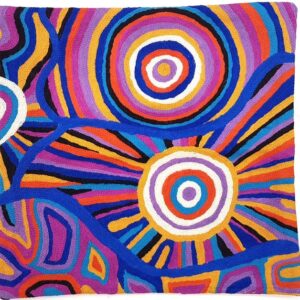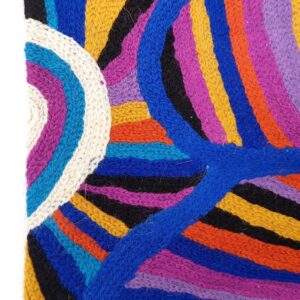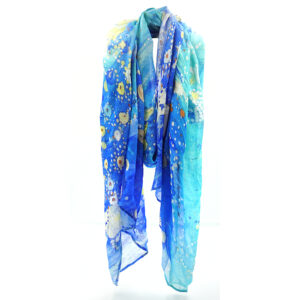Description
Composition: Hand dyed wool and cotton
Size: 61 x 91 cm (24 x 36 inches)
Features:
- Hand embroidered/chain-stitched
- All natural fibres – embroidered wool on cotton canvas
- Fair Trade certified
- Limited edition – individually numbered
- Certificate of Authenticity supplied with each kilim
- Royalties paid to the artist/family on every sale
- Hard wearing
- Back has non-slip surface
- Each kilim has flap on the rear for ease of hanging with dowel/rod
- Matching cushion covers are also available
Chain-stitched kilims are a traditional rug/soft furnishings making technique from Kashmir. As people sat on the floor they were both homewares and decoration. As many artworks are painted on the ground or 3D surfaces/bodies most of the images do not have a set orientation so can also be hung portrait or landscape if preferred.
About the artist:
“I learnt to paint by watching my mother, my sisters and my grandmother paint.” Athena Nangala Granites was born in 1994 in Alice Springs Hospital, the closest hospital to Yuendumu, a remote Aboriginal community 290 km from Alice Springs in the Northern Territory of Australia. She has lived most of her life in Yuendumu, attending the local school and graduating from Senior Girls Upper School in 2009. Since leaving school she has gained work experience working in the office at Mt Theo, a program that provides comprehensive training in youth development and leadership. She has also married Sebastian Jupurrurla Wilson and they have one son, “little Henry Peterson Wilson”. Athena enjoys being Mum to little Henry. Although young, Athena comes from a long line of artists. She is the daughter of Geraldine Napangardi Granites and the grand-daughter of Alma Nungarrayi Granites, well-known artists who paint with Warlukurlangu Artists. She is also the great grand-daughter of Paddy Japaljarri Sims (Deceased) one of the founding artists of Warlukurlangu Artists. Athena has been painting with Warlukurlangu Artists Corporation, an Aboriginal owned and governed art centre located in Yuendumu, since 2010. She paints Jukurrpa from her father’s side (Ngapa Jukurrpa – Water Dreaming) and her mother’s side (Ngalyipi Jukurrpa – Snake Vine Dreaming and Yanjirlpirri Jukurrpa – Seven Sisters Dreaming), stories which relate directly to her land, its features and the plants and animals that inhabit it. Athena uses an unrestricted palette to develop a modern interpretation of her traditional culture. When Athena is not painting and when the rain comes and it is cooler she likes to go hunting with her family for Honey Ants, Bush Banana, Goanna and Kangaroo.
*
About the design: Ngapa Jukurrpa (Water Ancestral Creation Story)
The site depicted in this painting is Puyurru, west of Yuendumu. At Warlura, a gecko called Yumariyumari blew the storm on to Lapurrukurra and Wilpiri. Bolts of lightning shot out at Wirnpa (also called Mardinymardinypa) and at Kanaralji. At this point the Dreaming track also includes the kurdukurdu mangkurdu Jukurrpa (children of the clouds Dreaming). The water Dreaming built hills at Ngamangama using baby clouds and also stuck long pointy clouds into the ground at Jukajuka, where they can still be seen today as rock formations. The termite Dreaming eventually continued west to Nyirrpi, a community approximately 160 km west of Yuendumu. The water Dreaming then travelled from the south over Mikanji, a watercourse with soakages northwest of Yuendumu. At Mikanji, the storm was picked up by a kirrkarlanji (brown falcon [Falco berigora]) and taken farther north. At Puyurru, the falcon dug up a giant warnayarra (rainbow serpent). The serpent carried water with it to create another large lake, Jillyiumpa, close to an outstation in this country. The kirda (owners) of this story are Jangala men and Nangala women. After stopping at Puyurru, the water Dreaming travelled on through other locations including Yalyarilalku, Mikilyparnta, Katalpi, Lungkardajarra, Jirawarnpa, Kamira, Yurrunjuku, and Jikaya before moving on into Gurindji country to the north.In contemporary Warlpiri paintings, traditional iconography is used to represent the Jukurrpa (Dreaming), associated sites, and other elements. In many paintings of this Dreaming, short dashes are often used to represent mangkurdu (cumulus & stratocumulus clouds), and longer, flowing lines represent ngawarra (flood waters). Small circles are used to depict mulju (soakages) and river beds.
Athena is a member of Warlukurlangu Artists of Yuendumu, Central Australia.
CARE INSTRUCTIONS:
Do not put place/use in direct sunlight or colors may fade. To clean – dry cleaning recommended. Can be ironed on a wool steam setting.
About the Better World Arts chainstitch kilim products
These beautiful, unique textiles are a cross-cultural collaboration combining Aboriginal designs and traditional Kashmiri rug-making techniques. Chain stitched, using hand dyed wool, each is a completely handmade piece. A more empowering way to work, this brings many direct benefits to the artists’ and their community. Control and ownership of intellectual property are also maintained. Purchase of these products guarantees a direct return to the Aboriginal artist and their community.
Warlukurlangu Artists was founded in 1985 in Yuendumu, 300 km north-west of Alice Springs in the Tanami Desert. It is home to Warlpiri people. The founder of Flying Fox Fabrics was the first manager of Warlukurlangu Artists from 1986-88 and has a deep love for Warlpiri people and their communities – and their art (of course).

